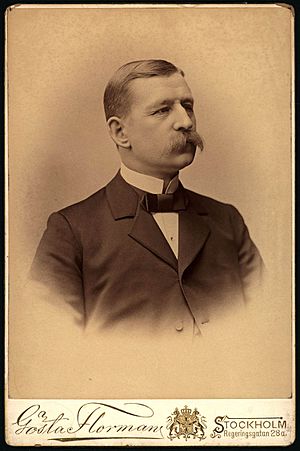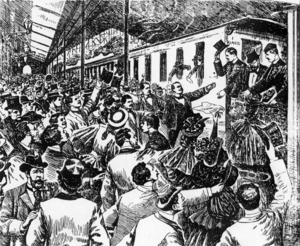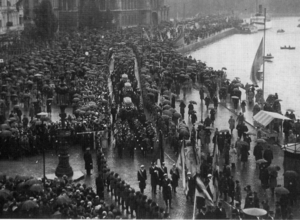Salomon August Andrée facts for kids
Quick facts for kids
Salomon August Andrée
|
|
|---|---|

Salomon August Andrée
|
|
| Born | 18 October 1854 |
| Died | October 1897 (aged 43) Kvitøya
|
| Citizenship | Swedish |
| Education | Royal Institute of Technology |
| Occupation | civil servant (Patent Office) |
| Known for | Arctic Balloon Expedition of 1897 |

Salomon August Andrée (born October 18, 1854, in Gränna, Småland, Sweden – died October 1897, in Kvitøya, Arctic Norway) was a Swedish engineer and polar explorer. He is best known for leading an attempt to reach the North Pole by hydrogen balloon. Sadly, the expedition was not successful, and all three people on board died.
Contents
Early Life and His Big Dreams
Andrée was born in the small town of Gränna, Sweden. He was very close to his mother, especially after his father passed away in 1870. He studied mechanical engineering at the Royal Institute of Technology in Stockholm and finished his degree in 1874.
In 1876, he traveled to the United States for the Centennial Exposition in Philadelphia. While there, he worked at the Swedish Pavilion. During this trip, he read a book about wind patterns and met an American balloon pilot named John Wise. These experiences sparked his deep interest in traveling by balloon.
After returning to Sweden, Andrée worked at the Swedish patent office starting in 1885. He also took part in a Swedish science trip to Spitsbergen in 1882–1883. On this trip, he studied air electricity. Andrée believed in new technology and scientific progress. He also thought that new inventions would help women gain more rights.
The North Pole Balloon Expedition
Andrée's plan to reach the North Pole by balloon gained a lot of attention. It was seen as a very brave and patriotic idea. Important people like King Oscar II and Alfred Nobel helped fund his project.
First Attempt and the Journey Begins
The expedition first tried to launch their balloon, named Örnen (The Eagle), in the summer of 1896. They were on Danes Island in the Svalbard Archipelago, but the winds were not right, so they had to wait.
On July 11, 1897, Andrée, along with engineer Knut Frænkel and photographer Nils Strindberg, finally launched the balloon. The balloon flew for 65 hours. However, right after lift-off, the balloon lost two of its three ropes. These ropes were meant to drag on the ice and help steer the balloon. Within ten hours, a strong storm hit them. The heavy winds and rain, which caused ice to form on the balloon, made it hard to fly. Andrée likely knew they would not reach the North Pole even before the flight ended.
Landing on the Ice and the Difficult Trek
Because of these problems, they had to land on the ice. The landing was somewhat controlled, not a crash. They had traveled about 295 miles (475 km) and were now stuck on the pack ice.
The expedition was prepared for traveling on ice. They had three sledges, a boat, and enough supplies for three months. They also had three supply points in northern Svalbard and one in Franz Josef Land. They first headed east towards Franz Josef Land. But after a week, they realized the ice currents were moving them west. So, they changed direction towards northern Svalbard.
Moving across the ice was very slow and tiring. The ice was rough, and they had to pull the heavy sledges themselves. Even though they had plenty of food, including polar bears they hunted, the constant effort against the moving, uneven ice wore them out.
Reaching Kvitøya and Their Final Days
In early October, after more than two months on the ice, they finally reached land. They landed on Kvitøya (White Island), which is just east of Svalbard. They likely died there within two weeks of arriving. Most experts believe Nils Strindberg died first and was buried among the rocks. The other two men were found later in their tent.
Their diary entries and notes stopped just a few days after they landed on Kvitøya. This suggests something serious happened soon after they arrived. The exact reason for their deaths is not fully known.
Some experts believe the men got sick from eating polar bear meat that had parasites called Trichinella. These parasites were found in the remains of a polar bear at their camp. The men's diaries mentioned they had stomach problems and felt tired during their journey on the ice.
Another idea, suggested by explorer Vilhjalmur Stefansson, was that Nils Strindberg might have died while chasing a polar bear, perhaps by drowning. He thought Andrée and Frænkel might have died from carbon monoxide poisoning from a faulty stove in their tent.
What Happened After?
For many years, no one knew what had happened to the expedition. There were many stories and rumors. In 1898, a Swedish expedition passed very close to Andrée's camp but could not land due to bad weather. Experts already suspected the expedition had not gone far because they knew the steering ropes were lost at the start.
Finally, in 1930, the remains of the three men were found by a Norwegian expedition. They found two bodies, notebooks, diaries, photos, and many other items. A month later, a newspaper-hired ship found the third body.
The return of Andrée, Strindberg, and Frænkel's bodies to Stockholm was a huge event. King Gustaf V gave a speech, and the explorers received a funeral with great honors. Their ashes were buried together in the Norra begravningsplatsen cemetery in Stockholm.
How People See Andrée Today
Since the 1960s, people have started to look at Andrée differently. He was once seen as a national hero, but now some question his decisions. Many believe the expedition was always likely to fail. They point out that Andrée did not listen to warnings about the plan's problems. He also had little experience flying large balloons, especially in the Arctic.
Some writers suggest that by the time he left in 1897, Andrée felt trapped by the public excitement and the money he had raised. He might have felt he could not back out or admit any weaknesses in his plans to the public.
Andrée's Legacy
- Andrée Land in Greenland was named after him by Swedish explorer A.G. Nathorst.
- The Italian poet Giovanni Pascoli wrote a poem about Andrée's journey.
- The American composer Dominick Argento created a series of songs called The Andrée Expedition.
- The Swedish composer Klas Torstensson's opera "Expeditionen" (1994–99) is also based on Andrée's story.
- The 1982 Swedish film Flight of the Eagle was based on a book about Andrée.
- In 2010, the American rock band Brian's Escape released an album inspired by Andrée's adventures.
- The 2010 novel Strindberg's Star by Swedish writer Jan Wallentin uses the expedition's story.
- In 2013, a UK/Norway theater company created a show called North North North about the balloon story.
- A 2013 novel Expeditionen : min kärlekshistoria by Swedish writer Bea Uusma tells the story from the viewpoint of Strindberg's love for his fiancée.
|
See also
 In Spanish: Salomon August Andrée para niños
In Spanish: Salomon August Andrée para niños



